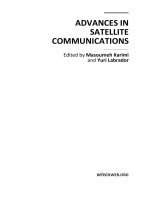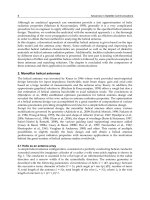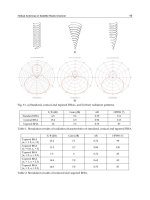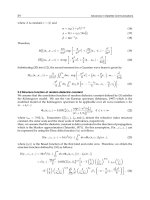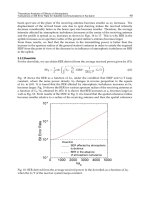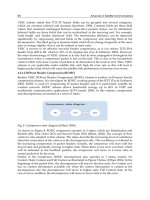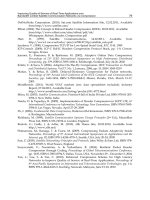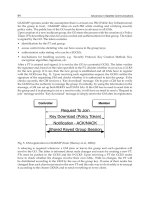Advances in Satellite Communications Part 5 potx
Bạn đang xem bản rút gọn của tài liệu. Xem và tải ngay bản đầy đủ của tài liệu tại đây (404.42 KB, 15 trang )
Theoretical Analysis of Effects of Atmospheric Turbulence on Bit Error Rate for Satellite Communications in Ka-band 21
beam spot size at the plain of the receiving antenna becomes smaller as w
0
increases. The
displacement of the arrived beam axis due to spot dancing makes the received intensity
decrease considerably faster as the beam spot size becomes smaller. Therefore, the average
intensity affected by atmospheric turbulence decreases at the center of the receiving antenna
and the profile is spread as w
0
increases as shown in Figs. 14 to 17. This is why BER in the
uplink increases as an aperture radius of the ground station’s antenna becomes larger.
From these results, we find that the increase in the transmitting power is better than the
increase in the aperture radius of the ground station’s antenna in order to satisfy the required
EIRP from the point of view of the decrease in an influence of atmospheric turbulence on BER
in the uplink.
3.3.2 Downlink
For the downlink, we can obtain BER derived from the average received power given by (53):
PE
P
=
1
2
erfc
S
P
·
T
b
k
B
· EIRP ·
1
(2kz
L
)
2
· G/T
. (67)
Fig. 18 shows the BER as a function of ka
e
under the condition that EIRP and G/T keep
constant, where the noise power density N
0
changes in inverse proportion to the square
of ka
e
in (63). It is found that the BER affected by atmospheric turbulence increases as ka
e
becomes larger. Fig. 19 shows the BER for various aperture radius of the receiving antenna as
a function of E
b
/N
0
obtained by (65). It is shown that BER increases as a
e
becomes larger as
well as Fig. 18. From results of the DOC in Fig. 9, it is found that the spatial coherence radius
becomes smaller relative to a radius of the receiving antenna and then the spatial coherence
Fig. 18. BER derived from the average received power in the downlink as a function of ka
e
when the G/T of the receiver system keeps constant.
49
Theoretical Analysis of Effects of Atmospheric
Turbulence on Bit Error Rate for Satellite Communications in Ka-band
22 Will-be-set-by-IN-TECH
Fig. 19. BER derived from the average received power in the downlink for various aperture
radius of the receiving antenna a
e
as a function of E
b
/N
0
.
of received waves decreases as the radius of the antenna increases. The effect of the spatial
coherence of received waves causes the decrease in the average received power and results in
the degradation of BER performance.
From these results, it is found that the decrease in the system noise temperature by the
improvement of a receiver’s noise is better than the increase in an aperture radius of the
ground station’s antenna in order to decrease an influence of atmospheric turbulence on BER
for the downlink in the design to satisfy the required G/T.
4. Conclusion
We analyzed BER derived from the average received power, which is deduced by the second
moment of a Gaussian wave beam, for the GEO satellite communications in Ka-band at low
elevation angles affected by atmospheric turbulence. We find the followings:
1. For the uplink, the decrease in the average received intensity caused by spot dancing of
wave beams degrades the BER performance. However, the spatial coherence of received
wave beams decreases little and there are little influences of this spatial coherence on BER.
2. For the downlink, the decrease in the spatial coherence of received wave beams degrades
the BER performance. However, spot dancing of wave beams influences little on BER.
3. In the design of the ground station, the increase in a transmitting power for the uplink or
the decrease in the noise temperature of the receiver system for the downlink is better than
the increase in an aperture radius of the ground station’s antenna in order to satisfy the
required EIRP of the transmitter system or G/T of the receiver system from the point of
view of the decrease in an influence of atmospheric turbulence on BER performance.
50
Advances in Satellite Communications
Theoretical Analysis of Effects of Atmospheric Turbulence on Bit Error Rate for Satellite Communications in Ka-band 23
In this chapter, we do not consider effects of the higher moment of a Gaussian wave beams
on BER. At the next stage, we will analyze effects of the fourth moment of received wave
beams on BER for the GEO satellite communications. Furthermore, we have to consider the
probability density function (PDF) about the bit error of satellite communications affected by
atmospheric turbulence in order to make a more actual analysis. An introduction of the PDF
is a future problem.
5. References
Andrews, L. C. & Phillips, R. L. (2005). Laser Beam Propagation through Random Media, 2nd edn,
SPIE Press.
Fante, R. L. (1975). Electromagnetic beam propagation in turbulent media, Proceedings of the
IEEE 63(12): 1669–1692.
Fante, R. L. (1980). Electromagnetic beam propagation in turbulent media: An update,
Proceedings of the IEEE 68(11): 1424–1443.
Hanada, T., Fujisaki, K. & Tateiba, M. (2008a). Theoretical analysis of bit error rate of satellite
communication in Ka-band under spot dancing and decrease in spatial coherence
caused by atmospheric turbulence, Progress In Electromagnetics Research C 3: 225–245.
Hanada, T., Fujisaki, K. & Tateiba, M. (2008b). Theoretical analysis of bit error rate of
satellite communications in Ka-band through atmospheric turbulence, Proceedings
of the 7th Asia-Pacific Engineering Research Forum on Microwaves and Electromagnetic
Theory, Fukuoka Institute of Technology, Fukuoka, Japan, pp. 7–13.
Hanada, T., Fujisaki, K. & Tateiba, M. (2009a). Average bit error rate for satellite downlink
communications in Ka-band under atmospheric turbulence given by Gaussian
model, Proceedings of 2009 Asia-Pacific Microwave Conference (APMC 2009), Singapore.
Hanada, T., Fujisaki, K. & Tateiba, M. (2009b). Average bit error rate for satellite uplink
communications in Ka-band under atmospheric turbulence given by Gaussian
model, Proceedings of the 15th Asia-Pacific Conference on Communications (APCC 2009),
Shanghai, China, pp. 438–441.
Hanada, T., Fujisaki, K. & Tateiba, M. (2009c). Theoretical analysis of bit error
rate for downlink satellite communications in Ka-band through atmospheric
turbulence using Gaussian model, Proceedings of 2009 Korea-Japan Joint Conference on
AP/EMC/EMT, Incheon, Korea, pp. 35–38.
Hanada, T., Fujisaki, K. & Tateiba, M. (2009d). Theoretical analysis of bit error rate for satellite
communications in Ka-band under atmospheric turbulence given by Kolmogorov
model, Journal of Electromagnetic Waves and Applications 23(11–12): 1515–1524.
Ippolito, L. J. (2008). Satellite Communications Systems Engineering: Atmospheric Effects, Satellite
Link Design and System Performance, John Wiley and Sons, Ltd.
Ishimaru, A. (1997). Wave Propagation and Scattering in Random Media, IEEE Press and Oxford
University Press.
Karasawa, Y., Yamada, M. & Allnutt, J. E. (1988). A new prediction method for tropospheric
scintillation on earth-space paths, IEEE Transactions on Antennas and Propagation
36(11): 1608–1614.
Karasawa, Y., Yasukawa, K. & Yamada, M. (1988). Tropospheric scintillation in the 14/11-GHz
bands on earth-space paths with low elevation angles, IEEE Transactions on Antennas
and Propagation 36(4): 563–569.
Martini, E., Freni, A., Facheris, L. & Cuccoli, F. (2006). Impact of tropospheric scintillation
in the Ku/K bands on the communications between two LEO satellites in a
51
Theoretical Analysis of Effects of Atmospheric
Turbulence on Bit Error Rate for Satellite Communications in Ka-band
24 Will-be-set-by-IN-TECH
radio occultation geometry, IEEE Transactions on Geoscience and Remote Sensing
44(8): 2063–2071.
Marzano, F. S., Riva, C., Banich, A. & Clivio, F. (1999). Assessment of model-based scintillation
variance prediction on long-term basis using Italsat satellite measurements,
International Journal of Satellite Communications 17: 17–36.
Matricciani, E., Mauri, M. & Riva, C. (1997). Scintillation and simultaneous rain attenuation
at 12.5 GHz to satellite Olympus, Radio Science 32(5): 1861–1866.
Matricciani, E. & Riva, C. (2008). 18.7 GHz tropospheric scintillation and simultaneous rain
attenuation measured at Spino d’Adda and Darmstadt with Italsat, Radio Science 43.
Mayer, C. E., Jaeger, B. E., Crane, R. K. & Wang, X. (1997). Ka-band scintillations:
Measurements and model predictions, Proceedings of the IEEE 85(6): 936–945.
Otung, I. E. (1996). Prediction of tropospheric amplitude scintillation on a satellite link, IEEE
Transactions on Antennas and Propagation 44(12): 1600–1608.
Otung, I. E. & Savvaris, A. (2003). Observed frequency scaling of amplitude scintillation at 20,
40, and 50 GHz, IEEE Transactions on Antennas and Propagation 51(12): 3259–3267.
Peeters, G., Marzano, F. S., d’Auria, G., Riva, C. & Vanhoenacker-Janvier, D. (1997). Evaluation
of statistical models for clear-air scintillation prediction using OLYMPUS satellite
measurements, International Journal of Satellite Communications 15: 73–88.
Rytov, S. M., Kravtsov, Y. A. & Tatarskii, V. I. (1989). Principle of Statistical Radiophysics 4 Wave
Propagation through Random Media, Springer-Verlag.
Strohbehn, J. W. (ed.) (1977). Laser Beam Propagation in the Atmosphere, in Topics in Applied
Physics, Springer-Verlag, Berlin and New York.
Tatarskii, V. I. (1961). Wave Propagation in a Turbulent Medium, McGraw-Hill, New York.
Tatarskii, V. I. (1971). The Effects of the Turbulent Atmosphere on Wave Propagation, Israel Program
for Scientific Translations, Jerusalem.
Tatarskii, V. I., Ishimaru, A. & Zavorotny, V. U. (eds) (1993). Wave Propagation in Random
Media (Scintillation), The Society of Photo-Optical Instrumentation Engineers and IOP
Publishing Ltd.
Tateiba, M. (1974). Moment equation of a wave propagating through random media, Memoirs
of the Faculty of Engineering, Kyushu University 33(4): 129–137.
Tateiba, M. (1975). Mechanism of spot dancing, IEEE Transactions on Antennas and Propagation
AP-23(4): 493–496.
Tateiba, M. (1982). Multiple scattering analysis of optical wave propagation through
inhomogeneous random media, Radio Science 17(1): 205–210.
Tateiba, M. (1985). Some useful expression for spatial coherence functions propagated through
random media, Radio Science 20(5): 1019–1024.
Uscinski, B. J. (1977). The Elements of Wave Propagation in Random Media, McGraw-Hill, Inc.
Vasseur, H. (1999). Prediction of tropospheric scintillation on satellite links from radiosonde
data, IEEE Transactions on Antennas and Propagation AP-47(2): 293–301.
Wang, T. & Strohbehn, J. W. (1974). Log-normal paradox in atmospheric scintillations, Journal
of the Optical Society of America 64(5): 583–591.
Wheelon, A. D. (2003). Electromagnetic Scintillation II. Weak Scattering, Cambridge University
Press.
52
Advances in Satellite Communications
Part 3
Real Time Applications over Satellite
3
Improving Quality-of-Service of Real-Time
Applications over Bandwidth Limited Satellite
Communication Networks via Compression
LingSun Tan, SeiPing Lau and ChongEng Tan
Universiti Malaysia Sarawak,
Malaysia
1. Introduction
VSAT (Very Small Aperture Terminal) satellite network is one of the widely deployed
communication networks for rural and remote communications in today’s
telecommunication world. VSAT satellite networks are growing steadily throughout many
industries and market segments in many countries. With new applications and shifts in
target markets, VSAT based solutions are being adopted at increasingly higher rates since
year 2002 (MindBranch, 2011). Up to December 2008, VSAT market statistics show that the
total number of Enterprise VSAT terminals being ordered is 2,276,348, the total number of
VSATs being shipped is 2,220,280 and the total number of VSAT sites in service is 1,271,900
throughout the world (Comsys, 2008). VSAT satellite network offers value-added satellite-
based services capable of supporting the Internet, data, video, LAN, voice and fax
communications. VSATs are a single, flexible communication platform which can be
installed quickly and cost efficiently to provide telecommunication solutions for consumers,
governments and corporations, thus, they are becoming increasingly important.
VSAT satellite network plays an important role in bridging the digital divide and it is the
one of the easiest deployment technology and cost effective way to interconnect two
networks especially in rural areas, when other wired technologies are practically impossible
and unsuitable due to geographical distance or accessibility. In this chapter, a fundamental
overview of satellite communication network, with the highlighting of its main
characteristics, constraints and proposal on compression technique which can be applied to
boost up the Quality of Service (QoS) of the satellite communication services, are provided.
VSAT satellite network provides communications support for a wide range of applications,
which include point-of-sales transaction, financial management, telemetry & data collection,
private-line voice services, virtual private networks, distance education, high speed internet
access and more (TM, 2011).
VSAT satellite technology has many advantages. It can be deployed anywhere around the
world and it offers borderless communication within the coverage area. Besides, it is cost
effective and can be setup in a matter of minutes. VSAT network configuration such as
bandwidth, interfaces and data rates can be updated remotely from the central network
management system, hence, it provides high flexibility and efficiency. However, like other
technologies, VSAT satellite network has its downsides. The limitations of VSAT technology
Advances in Satellite Communications
56
include the extremely high start-up cost needed for building and launching satellites in the
geosynchronous orbit, high round-trip latency of about 500 ms as it utilise the satellites in
geosynchronous orbit, and rain attenuation might affect the performance of VSAT
communications under rainy conditions (TopBits.com, 2011). Moreover, it provides low and
limited network bandwidth resulting in network congestion, reduced Quality-of-Service
(QoS) of real-time interactive multimedia applications and also late packet delivery issues.
These issues have created some negative impacts on the QoS of communication networks
and also user experiences.
Apart from the need for efficient mechanisms for storage and transfer of enormous volume
of data, these also lead to insatiable demands for ever-greater bandwidth in VSAT satellite
network. In order to strike a balance between the cost and offered satellite bandwidth, some
enhancements have to be implemented to reduce the bandwidth requirement of real-time
applications that demanding high bandwidth and fully optimize the use of the low speed
satellite link. Several techniques have been introduced to further improve the network
bandwidth utilization and reduce network traffic especially for wireless satellite networks
(Tan et al., 2010). One of such techniques is via compression, which is a technique used to
overcome the network packet overhead by eliminating redundancies in packet delivery. By
reducing the packet size, more packets can be transmitted over the same communication
link at one time and hence increase the efficiency of bandwidth utilization. In this chapter,
the concept of data compression is examined in order to know in depth how data
compression can actually play a role in improving user experience. After that, the basic
concept of packet compression, which consists of header compression and payload
compression is also discussed.
Currently, there are many compression schemes, systems and frameworks have been
proposed and designed in order to perform efficient data compression for better utilization
of the communication channel. However, most of them have their own advantages and
limitations, which may not suit for VSAT satellite network environment. For example, the
Adaptive Compression Environment (ACE) system which has been proposed might impose
additional delays over VSAT satellite network due to computation overhead and large
compression time cost of the algorithm used. Besides, the Adaptive Online Compression
(AdOC) algorithm which is proposed in the related work might cause the satellite link to be
more congested due to the increased network load caused by the algorithm. In addition,
some of the proposed compression schemes are designed for a specific aspect, which might
create additional issues working under VSAT satellite network. Thus, in this chapter, the
performance of several well-known compression schemes are reviewed and evaluated
under the context of bandwidth limited VSAT satellite network, in order to highlight
important criterions for improving performance over low bandwidth VSAT satellite
network. Finally, the proposed enhanced compression scheme will be presented and the
performance of the compression scheme will be examined and evaluated through extensive
network simulations.
2. Introduction to VSAT communication
VSAT satellite network has become an essential part of our daily lives in recent years. It is
used widely in telephony communication, broadband and internet services, and military
communication. VSAT is a small satellite dish that is capable of both receiving and sending
satellite signals (TM, 2011). It can be used for two-way communications via satellite.
Improving Quality-of-Service of Real-Time Applications over
Bandwidth Limited Satellite Communication Networks via Compression
57
Generally, satellite is a specialized wireless receiver or transmitter that is launched by a
rocket and placed in orbit around the earth (DotNetNuke Corporation, 2010). Thus, it is
capable of providing coverage over large geographical areas and establishing
communication links between various points on earth.
2.1 Basic satellite elements
Satellite communication system is comprised of two main components, namely space
segment and ground segment, as illustrated in Figure 1 below. A basic satellite
communication system consists of a space segment serving a specific ground segment
(Richharia, 1999). The satellite itself is also known as the space segment while the earth
stations will serve as the ground segment. The satellite is controlled and its performance is
monitored by the Telemetry Tracking and Command (TT&C) station.
Fig. 1. The main elements of a satellite communication network (Richharia, 1999).
Communication can be established easily between all earth stations located within the
coverage region through the satellite. The primary role of a satellite is to relay electronic
signals. When signals from the earth stations are received by the satellite, the signals are
processed, translated into another radio frequency and retransmitted down towards another
Advances in Satellite Communications
58
desired earth stations after further amplification. Satellite relay can be two way, as in the
case of a long distance phone call, and point to multipoint, as in the case with television
broadcasts.
2.2 Satellite roles and applications
The most important role of satellite communication network is to provide connectivity to
the user terminals and to internetwork with terrestrial networks so that the applications and
services provided by terrestrial network such as telephony, television, broadband access and
Internet connections can be extended to places where cable and terrestrial radio cannot
economically be installed and maintained. Satellite network provides direct connections
among user terminals, connections for terminals to access terrestrial networks and
connections between terrestrial networks (Mitra, 2005).
Since satellite is capable of providing coverage over a much wider area such as oceans, inter-
continental flight corridors and large expanses of land mass, it is used in providing voice
and data communications to aircraft, ships, land vehicles and handsets. Besides, satellite
allows passengers on an aircraft to connect directly to a land based telecommunication
network. Apart from that, it is also used for remote sensing, earth observation,
meteorological applications such as weather survey, military communication and global
positioning services (GPS).
2.3 Limitations of satellite communication
Three main characteristics and constraints of satellite network are high latency, poor
bandwidth and noise (Hart, 1997). High latency is one of the main limitations of satellite
network and it is caused by the long propagation path due to the high altitude of satellite
orbits. In satellite network, the time required to navigate through a satellite link is longer
compared to terrestrial network. Hence, this leads to higher transmission delay.
For geostationary (GEO) satellite communication system, the time required to traverse these
distances, namely, earth station to satellite, then satellite to another earth station, is around
250ms (Sun, 2005). Round-trip delay will be 500ms. These propagation times are much
greater than those encountered in conventional terrestrial systems. The high latency
constraint of satellite link might not affect bulk data transfer and broadcast-type
applications, but it will affect those highly interactive real-time applications.
Due to radio spectrum limitations, satellite transmission has a fixed amount of bandwidth
(Hart, 1997). Problems like network congestion and packet loss might occur when those real-
time interactive applications that consume high bandwidth are running over satellite link.
Furthermore, strength of radio signal is in proportion to the square of distance traveled
(Hart, 1997). Thus, signals traverse through satellite link might get very weak due to long
distance between earth stations and satellite.
3. Data compression
Data compression plays an important role in improving the performance of low bandwidth
VSAT satellite network. Among other satellite performance enhancement techniques, data
compression is the most suitable and economical way to further improve the user
experience of VSAT satellite network. This is because data compression technique is much
simpler and can be implemented easily. Currently, a lot of the networking corporations are
Improving Quality-of-Service of Real-Time Applications over
Bandwidth Limited Satellite Communication Networks via Compression
59
providing solutions for improving Internet services over satellite network by using high cost
network equipments. These products are very costly and require complicated hardware
configuration, while data compression is freely available and no complicated hardware
configuration is required. Thus, data compression is adopted in the proposed scheme.
Lately, data compression has become a common requirement for most application software
as well as an important and active research area in computer science study. None of the
ever-growing Internet, digital television, mobile communication or increasing video
communication techniques would have been the practical developments without applying
compression techniques.
In general, data compression is a process of representing information in a more compact
form by eliminating redundancies in the original data representation (Pu, 2006). Due to the
presence of redundancies in the original representation, data such as text, image, sound or
any combination of all these types such as video is not in the shortest form, thus rendering
its compression a possibility. Data compression is adopted in a variety of application areas
such as mobile computing, image archival, video-conferencing, computer networks, digital
and satellite television, multimedia evolution, imaging and signal processing. It can be
divided into two major categories, namely lossless and lossy compression.
3.1 Lossless compression
In lossless compression, the exact original data can be reconstructed from the compressed
data without any loss of information (Pu, 2006). Each compress-decompress cycle will
generate exactly similar data, hence, lossless compression is known as reversible
compression. Lossless compression techniques are used when storing medical images, text
and images preserved for legal reason, some computer executable files, database records,
spreadsheets or word processing files, where the lost of even a single bit could be
catastrophic.
Example of lossless data compression is shown in Figure 2, where the exact input string
FFMMMF is reconstructed after the execution of the compression algorithm followed by the
decompression algorithm.
Fig. 2. Example of lossless data compression (Pu, 2006).
3.2 Lossy compression
Lossy compression concedes a certain loss of accuracy in exchanges for greatly improved or
more effective compression ratio. Owning to that, it does not allow the exact original data to
be reconstructed from the compressed data (Pu, 2006). It usually suffers from information
loss as compressing and decompressing the file repeatedly will cause loss of quality
gradually. Thus, lossy compression is also known as irreversible compression. Lossy
Advances in Satellite Communications
60
compression is used frequently in streaming media and telephony applications as it is
proven to be effective over graphic images and digitized voice.
Lossy compression is not suitable for compressing text file formats due to loss of accuracy.
However, it produces a much smaller compressed file than any known lossless compression
method as it accepts some loss of data in order to achieve higher compression ratio.
Figure 3 shows an example of lossy data compression, where a long decimal number
becomes a shorter approximation number after the compression-decompression process.
Fig. 3. Example of lossy data compression (Pu, 2006).
4. Reviews of existing works
There are numerous compression schemes, systems and frameworks have been proposed
and designed in order to improve the performance of communication network. The
networking community has approached the problem of compressing network data streams
as packets come by (online scenario), while the database community has focused more on
applying such techniques to save storage space (offline scenario) (Chen et al., 2008).
However, most of them have their own characteristics, which may not be suitable for
satellite network environment. This section briefly discusses on packet compression, header
compression and payload compression. Several well known compression schemes are also
evaluated for their implementation under satellite network environment. These
compression schemes can be further divided into three categories, namely packet
compression schemes, header compression schemes and payload compression schemes.
4.1 Packet compression
Data compression in packet network is known as packet compression. Normally in
computer network, network data will be divided into smaller chunks before transmission
and transmitted as packets over the communication channel. Packet compression allows
much smaller amounts of packet drops, more simultaneous sessions, and a smooth and fast
behavior of applications (Matias & Refua, 2005). Since network packet consists of two parts,
namely header and payload, as shown in Figure 4, therefore packet compression can be
achieved by either header or payload compression, or the combination of both. Figure 5
depicts a basic packet compression.
Fig. 4. Structure of a network packet.
Improving Quality-of-Service of Real-Time Applications over
Bandwidth Limited Satellite Communication Networks via Compression
61
Fig. 5. Basic packet compression.
4.1.1 Packet compression schemes
Packet compression is proposed by some of the related works, as discussed in the following
sections.
4.1.1.1 IPzip
A comprehensive suite of algorithms known as IPzip is presented for network packet
headers and payloads compression. IPzip is designed to exploit the hidden intra-packet
correlation and inter-packet correlation properties of the data streams (Chen et al., 2008).
After that, it produces an efficient compression plan, where the data streams both within
and across packets are reorganized to improve the compression ratio. The compression plan
is built in an offline phase as reordering of packets and fields is resource intensive.
IPzip learns the correlation pattern over a training set, after that generates a compression
plan and then compresses the original data set according to the plan. However, the
performance of the current compression plan may decrease and new compression plan is
needed due to the changes in the intrinsic network traffic pattern. Thus, the effectiveness of
the compression plan will be monitored over time. Block compression is introduced, as
IPzip aggregates similar packets into a block based on flow information before undergoing
compression in order to increase compression ratio.
Unfortunately, IPzip may not suit for real-time processing as it needs to carry out offline
training to produce the efficient compression plan. Besides, IPzip may not be able to react if
the intrinsic network traffic pattern changes frequently, since the learning process to
generate a new compression plan takes time and efforts. Moreover, IPzip will simple cause
network congestion if the compression processing speed is slower than the relay processing
speed as it compresses all blocks. In conclusion, IPzip is not suitable for satellite network
environment.
Advances in Satellite Communications
62
4.1.1.2 Adaptive packet compression scheme for advanced relay node
This research work presented an adaptive lossless packet compression scheme especially for
advanced relay node in the network. This scheme is proposed to mitigate network traffic
congestion issue and it is based on the assumption that both the conventional packet delay
and additional advanced functions can be performed by the intermediate nodes inside the
network using computational or storage resources at the nodes (Shimamura et al., 2009).
This scheme compresses the incoming packets adaptively and selectively according to some
important metrics. Packet by packet compression is performed to evaluate the potential of
adaptive packet compression inside network.
Fig. 6. Adaptive compression model in advanced relay node (Shimamura et al., 2009).
Figure 6 shows the model of adaptive compression scheme proposed for advanced relay
node. Notice that an advanced relay node has two logical queues, which are CPU queue and
relay queue. When the advanced relay node receives a packet, this compression scheme
determines whether packet compression is effective according to the waiting time in the
relay queue, compression processing time, packet size, output link bandwidth and
compression ratio. If packet compression is beneficial, then compression will be performed
on the packet by the advanced relay node before the packet moves to the relay queue.
Simulation results show that this scheme succeeds in reducing the packet delay and packet
discard rate. However, the compression ratio achieved via per packet compression is very
much lower compared to the one with block compression. Therefore, this scheme will not
help much in bandwidth saving when working under low bandwidth satellite link. In
addition, massive computation which consume a lot of time needs to be done by the
advanced relay node each time it receives a packet. Under a heavy traffic condition which is
usually experienced in a low bandwidth satellite link, more and more calculation need to be
carried out, thus, more and more delays being created, and finally creates a bad impact on
user experience.
4.2 Header compression
The applicability of Internet technology over low speed and high delay links is threatened
and reduced by large and repetitive packet headers. Some delay sensitive applications, such
as remote login and real-time interactive multimedia applications, need to use small packets
(Naidu & Tapadiya, 2009). However, the overhead of large packet headers on small packets
can be prohibitive. A natural way to alleviate the problem is to compress packet header as
packet header information shows significant redundancy between consecutive packets.
Header compression makes more efficient use of link bandwidth in a packet switched
network by leveraging header field redundancies in packets belonging to the same packet
stream (Taylor et al., 2005).
Improving Quality-of-Service of Real-Time Applications over
Bandwidth Limited Satellite Communication Networks via Compression
63
Most of the header fields such as source and destination address remain constant
throughout the duration of a flow, while other fields such as sequence numbers change
predictably. Thus, the header size can be significantly reduced for most packets by sending
static fields information only initially and utilizing dependencies and predictability for other
fields. The reference copies of full headers must be stored at the context of compression and
decompression sides in order to communicate and reconstruct the original packet headers
reliably.
Initially, a few packets are sent uncompressed and they are used to establish the shared state
called context on both sides of the link. The context comprises information about static
fields, dynamic fields and their change pattern in protocol headers. The compressor will use
this information to compress the packet as efficiently as possible and then the decompressor
will decompress the packet to its original state. To correctly decompress the compressed
packet header, synchronization between compressor and decompressor is mandatory.
4.2.1 Header compression schemes
In order to overcome packet header overhead, two popular header compression schemes
have been developed. They are Van Jacobson header Compression (VJHC) scheme and
RObust Header Compression (ROHC) scheme.
4.2.1.1 Van Jacobson Header Compression (VJHC)
Van Jacobson Header Compression scheme was introduced by Jacobson in year 1990. This
scheme is used to improve the interactive terminal response of low speed serial modem
links and it is specially developed for Transmission Control Protocol/Internet Protocol
(TCP/IP) (Jacobson, 1990). VJHC is commonly used to compress the header of IPv4/TCP
packets.
Fig. 7. The flow context concept in header compression (Suryavanshi et al., 2004).
As shown in Figure 7, the concept of flow context is used during the process of header
compression. For each packet flow, the context is built on both the compressor and
decompressor side and a unique context identity (CID) is assigned. The flow context
information is made up of a collection of field values and change patterns of field values in
the packet header.
To establish the context, first few packets of a newly identified flow are sent to the
decompressor without compression. This is because the packet header information needed
to be stored for future reference. Once the context is formed on both sides, the compressor
starts compressing the packets and now only the encoded difference to the preceeding
header is transmitted. When the compressed packets reach the decompressor side, the
changes contained in the newly received compressed header is applied to the saved header
in the context to obtain the uncompressed headers.


